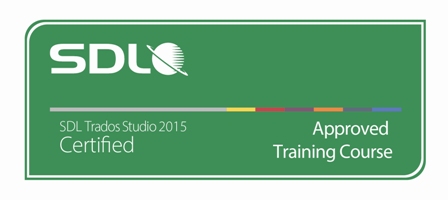SDL Trados Studio 2015 Getting Started Part 2: Working with the Supply Chain and Pre-production
Learning Objectives:
This course is designed as a follow up to the SDL Trados Studio 2015 Getting Started Part 1 course and covers the following functionality.
- Working within the translation supply chain - using SDL Trados Studio to process project packages (SDL Trados Studio and SDL WorldServer packages and SDL GroupShare)
- Delivering translation jobs to the supply chain
- Creating TMs and termbases using legacy content (e.g. converting Excel glossaries, aligning already translated documents, and generating your own AutoSuggest dictionaries)
Target Audience:
This course is designed for:
- translators who have already covered the SDL Trados Studio 2015 Getting Started Part 1 course
Prerequisites:
Attendance on the SDL Trados Studio Getting Started Part 1 course or equivalent knowledge.
SDL TRADOS Certification:
Together with SDL Trados Studio 2015 Getting Started Part 1 course, this course provides all of the knowledge attendees need to pass their SDL Trados Studio 2015 Getting Started exam.
The SDL Trados™ Certification program enables individual translators and project managers to validate their knowledge and expertise in the use of SDL Trados products. Achieving SDL Trados Certification demonstrates that you are fully prepared to work with the world’s leading translation technology.
The exam questions are based on the topics covered in the SDL Trados Studio 2015 – Getting Started Part 1 and 2 courses. Attendance on both courses, followed by practical experience of the topics covered, will prepare attendees to take the exam.
The exam consists of 40 questions and lasts 40 minutes. Attendees take their exams by logging into their SDL Account and selecting the Education area, where their exams and corresponding training manuals can be found.
Attendees will be advised on completion of their exam whether they have passed or need to retake
Further Development:
At the end of this course attendees will have covered all of the topics necessary to significantly increase translation speeds and productivity.
Attendees should also consider attending the following courses:
- SDL Trados Studio 2015 – Intermediate, which will teach you to go beyond the basics for more effective handling of translation projects
- SDL Trados Studio 2015 – Advanced, which will teach you to leverage advanced functionality to get the most out of the product
- SDL MultiTerm 2015 course, which will teach you the key functionality of SDL MultiTerm 2015
See upcoming courses here.
Further Information:
For further information on any of our courses, training delivery options and course dates, the SDL Certification programme or course fees please contact us at
contact us
TOPICS COVERED DURING THE COURSE
* Customizing the user interface
- Changing the editor font size
- Selecting your favorite source/target language pair
- Changing the Translation Results window display
SDL Trados Studio in the Supply Chain
•
SDL Trados Studio Project packages
• What are project packages?
• Opening a project package that was sent by the customer/project manager
• Reading the analyze results
• Opening the package files
• Translating the package files
- What are context matches?
- Choosing from several TM suggestions
- Searching for and inserting the correct terminology during translation
- Adding new terms on the fly
- Handling tags correctly
- Interactive tag verification
- Adding comments to your translation
- Filtering for segments, e.g. to show only segments that contain comments
• Creating the return package for delivery and marking the translation job as complete
•
SDL World Server (WS) packages
• What are SDL WorldServer packages?
• Opening a WS package
• Processing the files in the WS package
• What are PerfectMatches (PM)?
• Handling locked segments
• Delivering the translated files to WS and marking the translation job as complete
•
SDL GroupShare
• What is SDL GroupShare?
• How to accept SDL GroupShare assignments?
• How to deliver jobs through SDL GroupShare
Pre-Production
•
Re-using legacy documents to create translation memory content (Alignment)
• Running an alignment on an existing source and target document
- Creating a new (empty) TM
- Performing the alignment on single and multiple file pairs
- Reviewing the alignment result
- Correcting misalignments
- Importing the alignment result into the new TM (quick and advanced import)
•
Creating AutoSuggest dictionaries
• Creating your own AutoSuggest dictionary
•
Creating termbases
• Converting terms from an MS Excel document into SDL MultiTerm format
• Setting up a new termbase with SDL MultiTerm
• Importing the converted MS Excel glossary into the new termbase
•
Processing new documents based on legacy resources
• How to process a new document based on the alignment result, the newly-created termbase and AutoSuggest dictionary
- Opening the new document
- Analyzing the document against the newly-created TM
- Viewing the analysis report
- Translating the document using TM, termbase, and AutoSuggest dictionary
- Fine-tuning the AutoSuggest settings, e.g. prioritizing the AutoSuggest sources and changing the way the AutoSuggest hits are displayed




